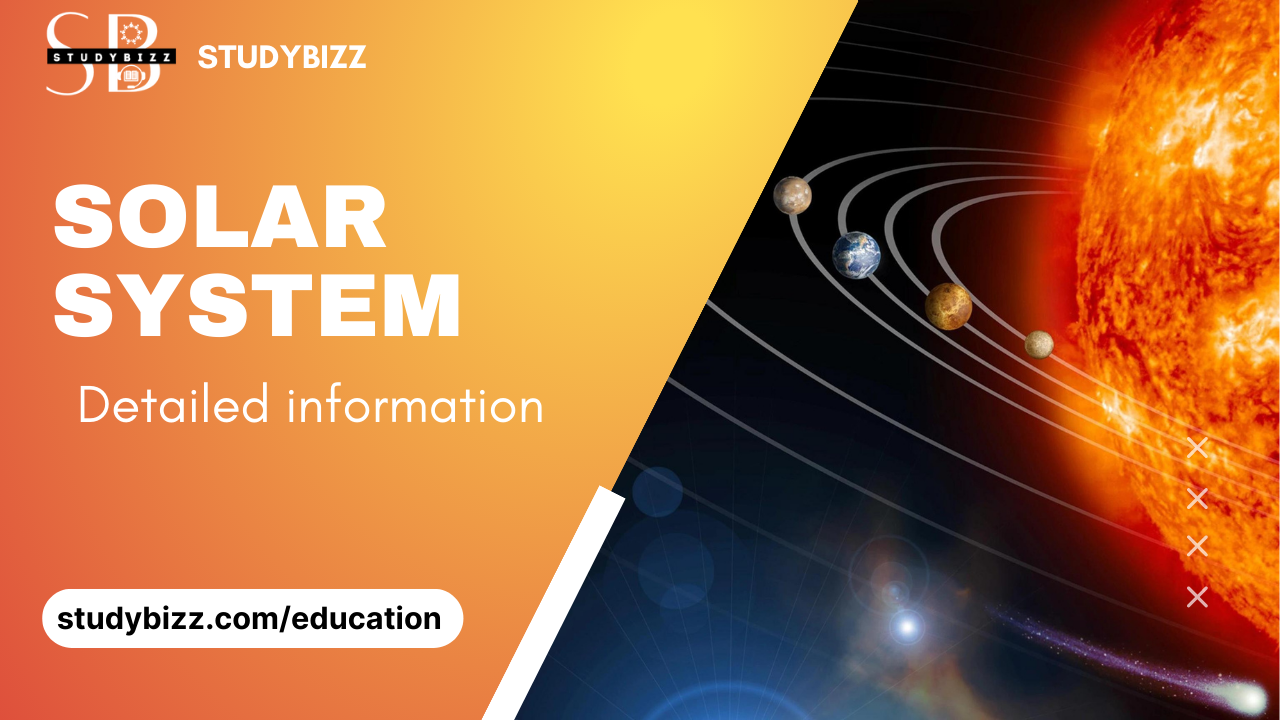The solar system is the collection of celestial objects that orbit the sun. It consists of the sun and everything bound to it by gravity, including the eight planets and their natural satellites, dwarf planets, and other objects. The solar system is located in the Milky Way galaxy and is believed to have formed around 4.6 billion years ago. The four terrestrial planets (Mercury, Venus, Earth, and Mars) are located near the sun and are primarily composed of rock and metal. The four outer Jovian planets (Jupiter, Saturn, Uranus, and Neptune) are called the gas giants because they are much larger than the terrestrial planets and are primarily composed of gas and ice.
Planets :
There are eight planets in the solar system: Mercury, Venus, Earth, Mars, Jupiter, Saturn, Uranus, and Neptune.
Here’s a brief overview of each one:
Mercury :
Mercury is the smallest and innermost planet in the solar system. It has a diameter of about 4,880 kilometers (3,032 miles) and a mass about a third that of Earth. It is made up of a rocky surface and has a very thin atmosphere consisting of hydrogen, helium, and oxygen.
Mercury is the closest planet to the sun and takes only 88 days to orbit the sun. Because of its close proximity to the sun, it experiences extreme temperature fluctuations, with temperatures ranging from -180 degrees Celsius (-292 degrees Fahrenheit) at night to 430 degrees Celsius (800 degrees Fahrenheit) during the day.
Mercury has a number of interesting features, including a large impact crater called the Caloris Basin, which is over 1,500 kilometers (932 miles) wide, and the planet’s surface is covered with numerous mountains and plains.
Mercury is named after the Roman messenger god because it appears to move quickly across the sky. It was visited by the Mariner 10 spacecraft in the 1970s, and the MESSENGER spacecraft conducted a detailed study of the planet from 2011 to 2015.
Venus :
Venus is the second planet from the sun and is often referred to as the Earth’s sister planet because it is similar in size, mass, and composition. It has a diameter of about 12,104 kilometers (7,521 miles) and a mass about 82% that of Earth.Venus has a thick, toxic atmosphere consisting mainly of carbon dioxide, with clouds of sulfuric acid. The planet has a surface temperature of about 462 degrees Celsius (863 degrees Fahrenheit), which is hot enough to melt lead. The high temperature is caused by a greenhouse effect in which the planet’s atmosphere traps heat from the sun.
Venus has a number of interesting features, including volcanoes and mountains. It has the highest volcano and the highest mountain in the solar system, both of which are called Olympus Mons. Venus also has a number of small volcanoes called “pancake volcanoes.”
Venus is named after the Roman goddess of love and beauty. It was visited by a number of Spacecraft, including the Mariner 2 probe in 1962, which was the first spacecraft to fly by Venus, and the Venus Express spacecraft, which orbited Venus from 2006 to 2014.
Earth :
Earth is the third planet from the sun and the only known planet to have life. It has a diameter of about 12,742 kilometers (7,917 miles) and a mass about 5.972 x 10^24 kilograms.
Earth has a diverse range of habitats, including mountains, forests, deserts, and oceans. It has a diverse range of plant and animal life, and its atmosphere contains oxygen, which is necessary for the existence of most life forms.
Earth has a number of interesting features, including the highest mountain, the deepest ocean trench, and the longest river. Mount Everest, located in the Himalayas, is the highest mountain, with a peak elevation of 8,848 meters (29,029 feet). The Mariana Trench, located in the western Pacific Ocean, is the deepest ocean trench, with a depth of about 11,000 meters (36,000 feet). The Nile River, located in Africa, is the longest river, with a length of about 6,695 kilometers (4,160 miles).
Earth has one natural satellite, the Moon, which is about a quarter the size of Earth and is the fifth-largest natural satellite in the solar system. The Moon is about 384,400 kilometers (238,855 miles) from Earth and takes about 27.3 days to orbit Earth.
Earth is the only planet in the solar system to have liquid water on its surface, and this is believed to be one of the reasons why life was able to evolve on the planet. The planet’s atmosphere and magnetic field also help protect life on Earth from the harmful effects of solar radiation.
Earth is named after the Old English word for “ground.” It has been visited by numerous spacecraft, including the Apollo missions, which landed astronauts on the Moon.
Mars :
Mars is the fourth planet from the sun and is known as the Red Planet because of its reddish appearance. It has a diameter of about 6,792 kilometers (4,212 miles) and a mass about 11% that of Earth.
Mars has a rocky surface with mountains, valleys, and polar ice caps. The planet has a thin atmosphere consisting mainly of carbon dioxide, with trace amounts of other gases such as nitrogen and oxygen. The atmosphere is not thick enough to protect the planet from the harmful effects of solar radiation, so the surface of Mars is exposed to high levels of ultraviolet radiation.
Mars has a number of interesting features, including the largest volcano and the longest canyon in the solar system. Olympus Mons is a shield volcano that is about 25 kilometers (16 miles) high and 600 kilometers (373 miles) wide. Valles Marineris is a canyon that is about 4,000 kilometers (2,500 miles) long and up to 7 kilometers (4.3 miles) deep.
There is evidence that liquid water may exist on Mars, and there is ongoing research to determine whether the planet could have supported life in the past or if it could potentially support life in the future.Mars has two small moons, Phobos and Deimos, which are believed to be asteroids that were captured by the planet’s gravity.
Mars is named after the Roman god of war. It has been visited by a number of spacecrafts, including the Mariner 9 probe in 1971, the Viking 1 and 2 landers in the 1970s, and the Curiosity rover, which has been exploring the planet’s surface since 2012.
Jupiter :
Jupiter is the fifth planet from the sun and is the largest planet in the solar system. It has a diameter of about 142,984 kilometers (88,746 miles) and a mass about 2.5 times that of all the other planets in the solar system combined.
Jupiter is a gas giant, which means that it is made up mainly of hydrogen and helium gas, with a small solid core. It has a thick atmosphere with clouds of ammonia and water, and it has a number of weather patterns, including the Great Red Spot, which is a giant storm that has been raging for hundreds of years.
Jupiter has a number of interesting features, including a system of rings and a number of moons. The planet has 79 known moons, the four largest of which are called the Galilean moons, after the astronomer who discovered them. These moons are Io, Europa, Ganymede, and Calisto, and they are some of the most interesting and well-studied moons in the solar system.
Jupiter is named after the Roman king of the gods. It has been visited by a number of spacecrafts, including the Pioneer 10 and 11 probes in the 1970s, the Galileo spacecraft, which orbited the planet from 1995 to 2003, and the Juno spacecraft, which has been studying the planet since 2016.
Jupiter is known for its beautiful system of rings, which are made up of small particles of ice and rock. The rings are not as prominent as the rings of Saturn, and they were not discovered until the 1970s, when they were observed by the Pioneer 10 and 11 probes. The rings are thought to be relatively young, possibly only a few hundred million years old.
Saturn :
Saturn is the sixth planet from the sun and is the second largest planet in the solar system. It has a diameter of about 120,536 kilometers (74,902 miles) and a mass about 95 times that of Earth.
Saturn is a gas giant, which means that it is made up mainly of hydrogen and helium gas, with a small solid core. It has a thick atmosphere with clouds of ammonia and water, and it has a number of weather patterns, including lightning and storms. Saturn is known for its beautiful system of rings, which are made up of small particles of ice and rock. The rings are made up of a number of smaller ringlets, and they are tilted relative to the planet’s equator. The rings are not as solid as they appear and are made up of individual particles that orbit the planet.
Saturn has a number of interesting features, including a number of moons and a system of rings. The planet has 82 known moons, the largest of which is called Titan. Titan is the second-largest moon in the solar system and is larger than the planet Mercury. It has a thick atmosphere and is thought to have a liquid ocean beneath its surface. Saturn is named after the Roman god of agriculture and wealth. It has been visited by a number of spacecrafts, including the Pioneer 11 probe in 1979 and the Cassini spacecraft, which orbited the planet from 2004 to 2017. The Cassini mission was a joint venture between NASA, the European Space Agency, and the Italian Space Agency, and it was the first mission to study Saturn and its moons in detail.
Uranus :
Uranus is the seventh planet from the sun and is the third largest planet in the solar system. It has a diameter of about 51,118 kilometers (31,763 miles) and a mass about 14.5 times that of Earth. Uranus is a gas giant, which means that it is made up mainly of hydrogen and helium gas, with a small solid core. It has a thick atmosphere with clouds of methane and ammonia, and it has a number of weather patterns, including storms and winds.
Uranus is known for its unusual tilt, which causes the planet to spin on its side. The planet’s axis of rotation is tilted about 98 degrees relative to its orbit around the sun, which means that the planet’s seasons are extreme. During the summer, one pole of the planet is pointed directly at the sun, while during the winter, the other pole is pointed at the sun.
Uranus has a number of interesting features, including a number of moons and a system of rings. The planet has 27 known moons, the largest of which is called Titania. Titania is the largest of Uranus’ moons and is about the size of the planet Mercury. It is thought to be made up of ice and rock and has a number of interesting features, including mountains and valleys.
Uranus is named after the Greek god of the sky. It was discovered in 1781 by the astronomer William Herschel, and it was the first planet to be discovered using a telescope. Uranus has been visited by a single spacecraft, the Voyager 2 probe, which flew by the planet in 1986.
Neptune :
Neptune is the eighth planet from the sun and is the fourth largest planet in the solar system. It has a diameter of about 49,528 kilometers (30,775 miles) and a mass about 17 times that of Earth. Neptune is a gas giant, which means that it is made up mainly of hydrogen and helium gas, with a small solid core. It has a thick atmosphere with clouds of methane and ammonia, and it has a number of weather patterns, including storms and winds.
Neptune is known for its blue colour ,which is caused by the presence of methane in the planet’s atmosphere. The methane absorbs red light and reflects blue light, giving the planet its distinctive hue.
Neptune has a number of interesting features, including a number of moons and a system of rings. The planet has 14 known moons, the largest of which is called Triton. Triton is the largest of Neptune’s moons and is about the size of the planet Mercury. It is thought to be made up of ice and rock and has a number of interesting features, including mountains and plains. Triton is a “cold” moon, with a surface temperature of about -235 degrees Celsius (-391 degrees Fahrenheit).Neptune is named after the Roman god of the sea. It was discovered in 1846 by the mathematician Urban Le Verrier and the astronomer Johann Gottfried Galle.
Disclaimer: This content is prepared and presented by studybizz.com and is purely for educational purpose. Any misuse or misapplication is subject to the laws by DMCA and Google.





Leave a Reply